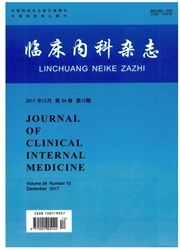

 中文摘要:
中文摘要:
目的探讨结核性心包炎患者快速进展至心包缩窄的临床特征、预测因素和治疗预后。方法将58例结核性缩窄性心包炎患者,分为快速进展性结核性缩窄性心包炎(快速进展组)和普通结核性缩窄性心包炎(普通组)两组,分析两组患者在临床特征和治疗预后等方面的差异,回归分析各相关因素的预后判断价值。结果12例患者在3个月内即发生心包缩窄,诊断为快速进展性结核性心包炎,其中心包填塞、血性心包积液、心包积液纤维素样物质漂浮、肝功能损害等指标在快速进展性结核性心包炎组显著高于普通组。快速进展性缩窄性心包炎患者往往病情更重,治疗更困难,但及时的手术治疗仍可降低其死亡率。结论心包填塞、血性心包积液和心包积液纤维素样物质漂浮可预测急性结核性心包炎快速进展至心包缩窄,此类患者如形成缩窄,亦应及时手术治疗。
 英文摘要:
英文摘要:
Objective To explore the clinical characteristics,relative factors, and prognosis of tuberculous pericarditis with rapid progression to constriction. Methods 58 patients with definite tuberculous constrictive pericarditis were recruited, and the patients were divided into tuberculous pericarditis with rapid progression to constriction group and common tuberculous constriction group. The differences of clinical characteristics between these two groups were analyzed and compared and regression analysis was performed among the variables. Results There were 12 patients reached the diagnosis criterion of tuberculous pericarditis with rapid progression to constriction, the percentages of pericardial tamponade, pericardial hemorrahagic effusion, and fibrinous materials floating in the effusion, and hepatic damage in rapid progression group were higher than in control group significantly. Pericardectomy decreased the mortality in rapid progression group. Conclusion Pericardial tamponade, pericardial hemorrahagic effusion, and fibrinous materials floating in the effusion were three useful factors which indicated the rapid progression to constriction in tuberculous pericarditis. The patients with rapid progression to constriction should be operated in time.
 同期刊论文项目
同期刊论文项目
 同项目期刊论文
同项目期刊论文
 期刊信息
期刊信息
